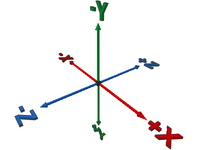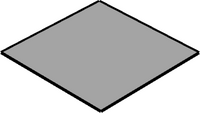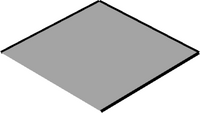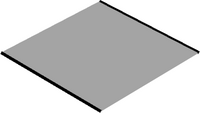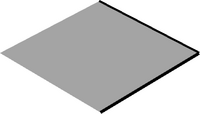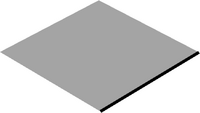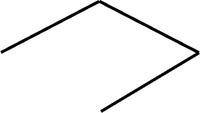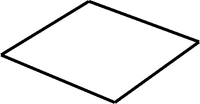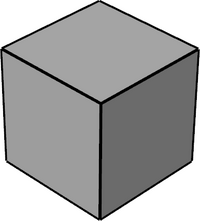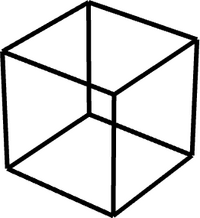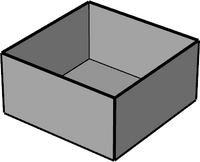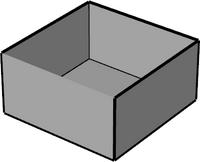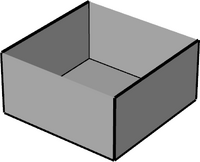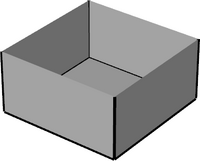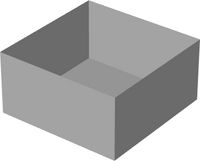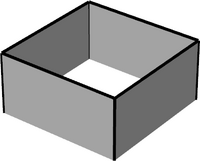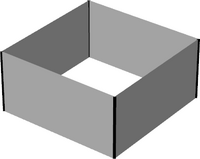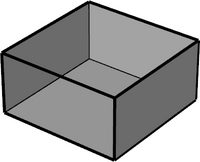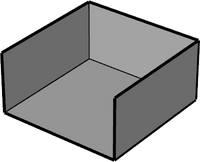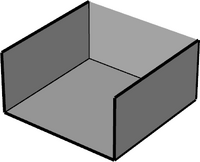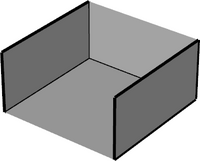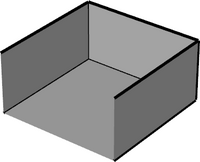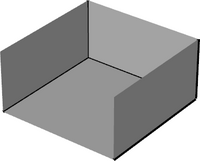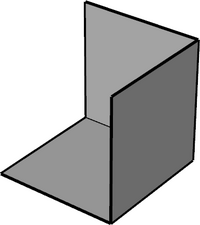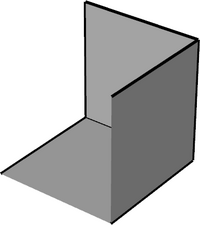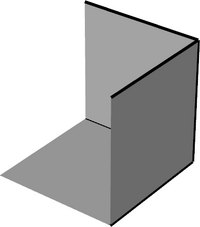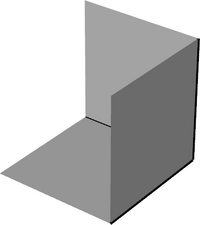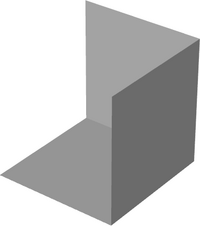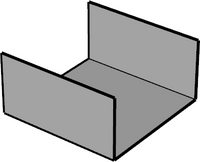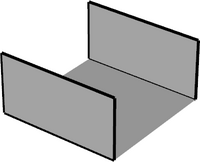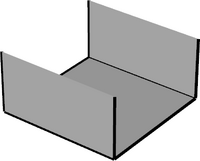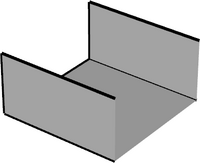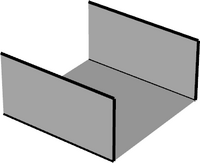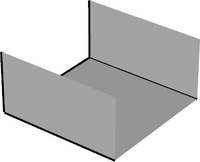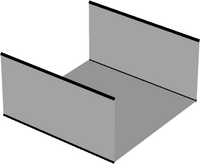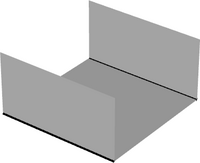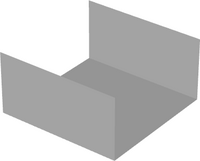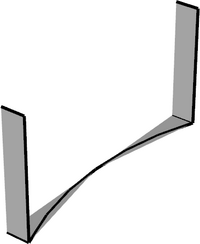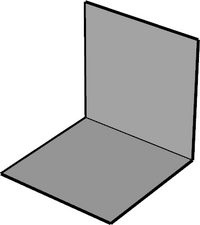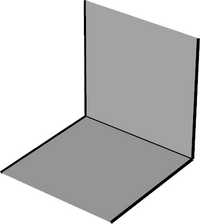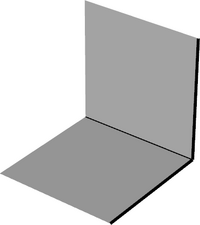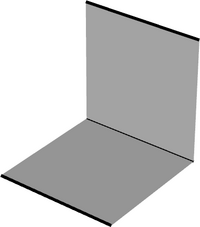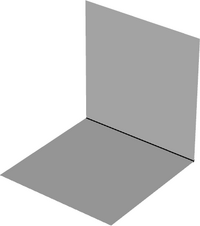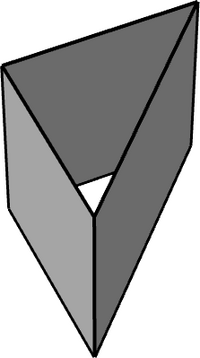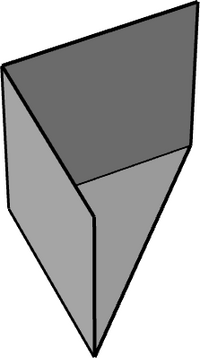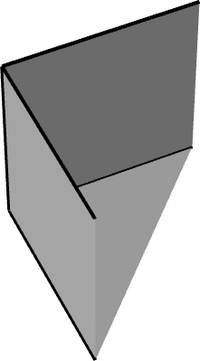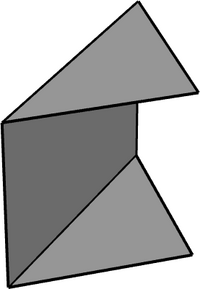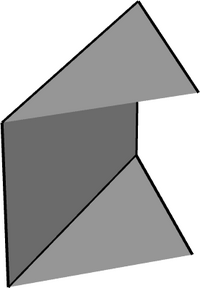Primitives Reference: Difference between revisions
Holly-Wood (talk | contribs) No edit summary |
Holly-Wood (talk | contribs) No edit summary |
||
| Line 99: | Line 99: | ||
| [[File:box.png|200px|thumb|alt=Box]] | | [[File:box.png|200px|thumb|alt=Box]] | ||
|| This primitive is used to define a cuboid. Its origin is the centre of the cuboid and by default has a size of 2LDu in each of the three dimensions. | || This primitive is used to define a cuboid. Its origin is the centre of the cuboid and by default has a size of 2LDu in each of the three dimensions. | ||
|- | |||
|- | |||
| '''box0.dat''' || '''Cuboid with no faces and edges''' | |||
|- | |||
| [[File:box0.png|200px|thumb|alt=Box0]] | |||
|| This primitive is used to define the frame a cuboid. Its origin is the centre of the cuboid and by default has a size of 2LDu in each of the three dimensions. | |||
|- | |- | ||
| Line 312: | Line 319: | ||
| [[File:box2-5.png|200px|thumb|alt=Box2-5]] | | [[File:box2-5.png|200px|thumb|alt=Box2-5]] | ||
|| This primitive represents a cuboid missing the top {-y}, front {-z}, left {-x} and right {+x} faces and excludes all the edges which do not bound the included faces. Its origin is the centre of the cuboid and by default has a size of 2LDu in each of the {x}, {y} and {z} dimensions. | || This primitive represents a cuboid missing the top {-y}, front {-z}, left {-x} and right {+x} faces and excludes all the edges which do not bound the included faces. Its origin is the centre of the cuboid and by default has a size of 2LDu in each of the {x}, {y} and {z} dimensions. | ||
|- | |||
|- | |||
| '''box2-7.dat''' || '''Cuboid with 2 adjacent faces missing 7 edges''' | |||
|- | |||
| [[File:box2-7.png|200px|thumb|alt=Box2-7]] | |||
|| This primitive represents a cuboid missing the top {-y}, front {-z}, left {-x} and right {+x} faces and excludes all the edges except that at the join between the two faces and those along the left {-x} and right {+x} sides. Its origin is the centre of the cuboid and by default has a size of 2LDu in each of the {x}, {y} and {z} dimensions. | |||
|- | |||
|- | |||
| '''box2-9.dat''' || '''Cuboid with 2 adjacent faces missing 9 edges (all except those connected to the {+x}, {+y}, {+z} vertex)''' | |||
|- | |||
| [[File:box2-9.png|200px|thumb|alt=Box2-9]] | |||
|| This primitive represents a cuboid missing the top {-y}, front {-z}, left {-x} and right {+x} faces and excludes all the edges except that at the join between the two faces and those along the right {+x} sides. Its origin is the centre of the cuboid and by default has a size of 2LDu in each of the {x}, {y} and {z} dimensions. | |||
|- | |||
|- | |||
| '''box2-9p.dat''' || '''Cuboid with 2 adjacent faces missing 9 edges (all except three parallel edges)''' | |||
|- | |||
| [[File:box2-9p.png|200px|thumb|alt=Box2-9p]] | |||
|| This primitive represents a cuboid missing the top {-y}, front {-z}, left {-x} and right {+x} faces and excludes all the edges except that at the join between the two faces and those parallel to that. Its origin is the centre of the cuboid and by default has a size of 2LDu in each of the {x}, {y} and {z} dimensions. | |||
|- | |||
|- | |||
| '''box2-11.dat''' || '''Cuboid with 2 adjacent faces missing 11 edges''' | |||
|- | |||
| [[File:box2-11.png|200px|thumb|alt=Box2-11]] | |||
|| This primitive represents a cuboid missing the top {-y}, front {-z}, left {-x} and right {+x} faces and excludes all the edges except that at the join between the two faces. Its origin is the centre of the cuboid and by default has a size of 2LDu in each of the {x}, {y} and {z} dimensions. | |||
|- | |||
|- | |||
| '''tri3.dat''' || '''Right-angled triangular prism with 3 faces''' | |||
|- | |||
| [[File:tri3.png|200px|thumb|alt=Tri3]] | |||
|| This primitive represents a triangular prism missing the top {-y} and bottom {+y} faces but including all edges. The left {-x} and front {-z} faces are perpendicular. Its origin is the right-angle corner of the (missing) top face and by default has a size of 1LDu in each of the {x} and {z} dimensions and 1LDu in the {y} dimension. | |||
|- | |||
|- | |||
| '''tri3a1.dat''' || '''Right-angled triangular prism with 3 adjacent faces missing 1 edge''' | |||
|- | |||
| [[File:tri3a1.png|200px|thumb|alt=Tri3a1]] | |||
|| | |||
|- | |||
|- | |||
| '''tri3a4''' || '''Right-angled triangular prism with 3 adjacent faces missing 4 adjacent edges''' | |||
|- | |||
| [[File:tri3a4.png|200px|thumb|alt=Tri3a4]] | |||
|| | |||
|- | |||
|- | |||
| '''tri3u1.dat''' || '''Right-angled triangular prism with 3 faces missing 1 edge''' | |||
|- | |||
| [[File:tri3u1.png|200px|thumb|alt=Tri3u1]] | |||
|| This primitive represents a triangular prism missing the left {-x} and front {-z} faces. Its origin is the right-angle corner of the top face and by default has a size of 1LDu in each of the {x} and {z} dimensions and 1LDu in the {y} dimension. | |||
|- | |||
|- | |||
| '''tri3u3.dat''' || '''Right-angled triangular prism with 3 faces missing 3 edges''' | |||
|- | |||
| [[File:tri3u3.png|200px|thumb|alt=Tri3u3]] | |||
|| This primitive represents a triangular prism missing the left {-x} and front {-z} faces, the edge where they would join and one edge of each of the triangles. Its origin is the right-angle corner of the top face and by default has a size of 1LDu in each of the {x} and {z} dimensions and 1LDu in the {y} dimension. | |||
|-} | |-} | ||
==Curved primitives== | |||
LDraw represents curved surfaces as polygons. For circular components two series of primitives are provided. | |||
All the circular primitives are orientated in the {x,z} plane with their origin at the centre of the circle and a default radius of 1 LDu. Primitives are provided for complete circles and for commonly used fractions of a complete circle. Where the naming convention includes a prefix of the form n-f this indicates the fraction (n/f) of the circle drawn by the primitive. Where this fraction is less than an entire circle, the primitive starts at {+x,0} and progresses in a conterclockwise direction when viewed from above {-y}. | |||
To avoid rounding errors, it is preferable to use existing fractional circular primitives, or create a new primitive, rather than rotate an existing primitive by anything other than 90 or 180 degrees. For example, use 3-16XXXX.dat rather than combining 1-8XXXX.dat with 1-16XXXX.dat rotated by 22.5 degreees. | |||
Revision as of 06:14, 29 November 2023
LDraw Primitives Reference
This page is a source of reference for the LDraw primitives in the \LDraw\p directory. Primitives are defined as highly re-usable components of LEGO parts modelled for LDraw. They serve several purposes :
* To speed up parts authoring by providing a library of components which can be incorporated into several parts * To allow rendering software to make substitutions of curved components
Within this reference material the available primitives are categorised into:
Each section contains an overview of the characteristics common to all primitives within that category. Primitives are grouped into classes within each category - one class of primitive serving a similar purpose at different sizes or resolutions. For each class of primitive, a brief description of the purpose of the primitive is provided, with notes on its co-ordinate origin, default size and rules for scaling. A list of the available primitives is shown.
An understanding of the orientation of the co-ordinate axes is essential for authoring a part for LDraw. For reference within this page the axes and their direction is shown in this diagram.
Rectilinear primitives
These rectilinear elements may be scaled in the {x}, {y} and {z} dimensions to make elements of any size. For example
1 16 0 0 0 40 0 0 0 1 0 0 0 20 rect.dat
would generate a 80LDu x 40LDu rectangle in the {x,z} plane.
Although the default orientation of the rect.dat primitive is in the {x,z} plane the LDraw language allows for this to be transformed
1 16 0 0 0 0 1 0 40 0 0 0 0 20 rect.dat
would generate a 80LDu x 40LDu rectangle in the {y,z} plane.
1 16 0 0 0 40 0 0 0 0 20 0 1 0 rect.dat
would generate a 80LDu x 40LDu rectangle in the {x,y} plane.
Curved primitives
LDraw represents curved surfaces as polygons. For circular components two series of primitives are provided.
All the circular primitives are orientated in the {x,z} plane with their origin at the centre of the circle and a default radius of 1 LDu. Primitives are provided for complete circles and for commonly used fractions of a complete circle. Where the naming convention includes a prefix of the form n-f this indicates the fraction (n/f) of the circle drawn by the primitive. Where this fraction is less than an entire circle, the primitive starts at {+x,0} and progresses in a conterclockwise direction when viewed from above {-y}.
To avoid rounding errors, it is preferable to use existing fractional circular primitives, or create a new primitive, rather than rotate an existing primitive by anything other than 90 or 180 degrees. For example, use 3-16XXXX.dat rather than combining 1-8XXXX.dat with 1-16XXXX.dat rotated by 22.5 degreees.
